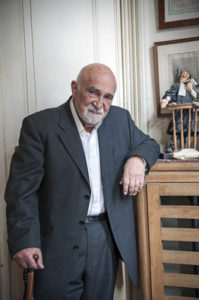A Race to Preserve the Voices of Holocaust’s Last Survivors
Daily News Article — Posted on December 19, 2013

Simon Gronowski was a child when he jumped off a train heading to Auschwitz, after being held in Belgium. (Photo: Cédric Gerbehaye for The Wall Street Journal)
(by Naftali Bendavid, The Wall Street Journal) JEMEPPE-SUR-SAMBRE, Belgium — Simon Gronowski, an 82-year-old Holocaust survivor, mesmerized schoolchildren in this small town recently with a detailed account of jumping off a train to Auschwitz and hiding from the Nazis for three years.
The students lobbed close to 50 questions at him, ranging from the unsophisticated – “Did you meet Hitler ?” – to the sensitive, like his feelings about losing the mother and sister who stayed on the train.
But the talk exhausted Mr. Gronowski. His knees bother him, he doesn’t hear that well, and it isn’t clear how much longer he can deliver such talks, though he has no plans to stop. “My children and my grandchildren will talk about it,” he said. “I can’t do any more than I’m doing.”
Mr. Gronowski’s plight underlines an increasingly urgent problem facing those seeking to memorialize the Holocaust: Nearly seven decades after World War II ended, the final survivors are aging and dying off, making it immensely harder to convey the tragedy’s reality. …
A survivor who was 20 when Auschwitz was liberated would be 88 today, and already few are left who were adults during the war. “Nothing has as much impact as seeing the person in real life,” said Regina Sluszny, 74, who was hidden from the Nazis as a child. “But we have no choice. We can’t live forever.”
The Claims Conference, which negotiates with Germany on payments to survivors, says roughly 160,000 people remain world-wide who lived in Nazi camps [work camps or concentration camps] or ghettos, or who hid during the war. But that is a broad category, and many are frail or isolated, so the number of active witnesses is a fraction of that, especially in some specific cases. Of the 850,000 people slated for extermination at the Treblinka death camp in Poland, for example, 67 survived the war. Of those, two remain, according to the Museum of Struggle and Martyrdom in Treblinka.
Figures for camps that focused on forced labor rather than killing are more complex, because more inmates survived and moved among camps. Bergen-Belsen, in Germany, had roughly 50,000 inmates at liberation, though about 10,000 died within weeks. Today, the Bergen-Belsen Memorial and Museum knows of about 2,000 survivors.
The world’s Holocaust memorials are scrambling to react. The U.S. Holocaust Memorial Museum and Israel’s Yad Vashem are accelerating their collection of personal artifacts like dolls and diaries. Almost all Holocaust museums now feature eyewitness recordings. The Shoah Foundation, founded by Steven Spielberg, is developing holograms of survivors that can interact with visitors.
But these are responses, not replacements. After the war, Holocaust survivors were initially slow to speak, partly because a world focused on healing didn’t seem that interested. But a desire to scrutinize the Holocaust has grown sharply over the decades, and a few years ago survivors began telling their stories, driven by a need to rebut Holocaust deniers and a recognition that they wouldn’t be around forever.

Polish-born Holocaust survivor Meyer Hack shows his prisoner number tattooed on his arm. (Photo: Baz Ratner – Reuters/Corbis)
Now talks by survivors are a central way the story is told, and the looming loss is evident each time they speak. Chil Elberg, 89, who was held in a dozen camps, addressed about 180 teenagers recently in Brussels, at one point rolling up his sleeve to show his Auschwitz tattoo, number B-10785. “There are people who say it never existed. This way, you know,” he said.
Mr. Elberg recounted arriving in Auschwitz, seeing the giant flame from the crematoria and thinking, “This is the end.” His family was immediately killed, but he was assigned the task of transferring bodies from the gas chambers to the crematoria. He ultimately survived the war by adopting the identity of a political prisoner who had recently died.
The students were transfixed, their hands occasionally flying to their mouths as Mr. Elberg spoke. “It’s shocking to know we are [among] the last to hear him,” Jessica Kraaijer, 17, said afterward. “In 10 years it will only be teachers and people like us who know the stories.”
Of the roughly 1,800 Jews on Mr. Elberg’s train from Belgium to the camps, 18 survived the war, and Mr. Elberg said he believes he is the only one still alive. …
Auschwitz inmate Paul Halter, a leader of the Belgian resistance, created the Auschwitz Foundation for research and education and personally spoke to about 1,000 groups. He told stories only a survivor would know – like how guards killed a prisoner one frigid day by dousing him with water, then forcing other inmates to watch him freeze to death.
Mr. Halter can no longer tell his stories, having died in March at age 92.
The survivors’ passing is a world-wide phenomenon, but in a sense it is more dramatic in Europe because this is where the Holocaust happened. Survivors often returned to their old neighborhoods after the war, and some are living there still.
In Belgium, the Nazis deported 25,482 Jews, and about 1,250 survived the war. Of those, at most 20 to 30 remain, said Henri Goldberg, a friend of Mr. Halter’s who now heads the Auschwitz Foundation.
Mr. Halter is among those featured in “The Irreversible,” a new book on the final survivors by Polish photographer Maciek Nabrdalik. Mr. Nabrdalik started the project after a 2009 trip to Auschwitz, when he noticed inmates’ obituaries posted by the gate almost daily.
At least 10 of the 42 survivors he photographed for the book have since died. “I think this was the last moment to start it,” Mr. Nabrdalik said.
Libraries and other institutions are trying to help by recording survivors, while museums are hustling to gather wartime belongings, which can tell moving stories in themselves. Yale University’s Fortunoff Video Archive has recorded more than 4,400 testimonies; the Shoah Foundation Institute at the University of Southern California has close to 52,000.
The most eye-catching effort is the Shoah Foundation’s project to create lifelike holograms of survivors, which aims for completion within five years. Visitors will be able to ask the “survivors” questions and, if it works, receive natural-seeming responses.
Some find such re-creations inappropriate, even vulgar. “It ends up being like a fictionalization technique,” said James Young, professor of English and Judaic studies at the University of Massachusetts Amherst. “It’s like creating a survivor. There is something robotic about it.”
Stephen D. Smith, executive director of the Shoah Foundation, said that the project in fact honors survivors, done in high-definition that helps create a beautiful image. “We’re not trying to trick the students – it’s not a Disneyland ride or haunted image,” he said.
Mr. Smith also said the holograms won’t be unveiled until the technology has matured “to the point that it does justice to the subject.” Another consideration is the survivors themselves. While they are alive, he said, “we don’t want to pre-empt them and say, ‘Thanks very much, we’ll now replace you with a true lifelike version of you.’ “
The questions raised by the survivors’ aging go deeper than educational techniques. With their fading, the Holocaust is transforming from memory to history, and it is now being fitted into its long-term place in the Western narrative.
…..
Copyright 2013 Dow Jones & Company, Inc. All Rights Reserved. Originally published at WSJ Dec. 5, 2013. Reprinted here for educational purposes only. Visit the website at wsj.com.
Background
Before the outbreak of World War II, there were an estimated 16.5 million Jews in the world.
- The Holocaust, also known as Shoah (Hebrew "the catastrophe"; Yiddish: from the Hebrew for "destruction"), was the mass murder or genocide of approximately six million Jews during World War II, a program of systematic state-sponsored murder by Nazi Germany, led by Adolf Hitler and the Nazi Party, throughout the German Reich and German-occupied territories.
- Of the nine million Jews who had resided in Europe before the Holocaust, approximately two-thirds were killed.
- Over one million Jewish children were killed in the Holocaust, as were approximately two million Jewish women and three million Jewish men.
- A network of over 40,000 facilities in Germany and German-occupied territory were used to concentrate, hold, and kill Jews and other victims. (from wikipedia)
More from the WSJ article:
Mr. Gronowski, who favors jeans and sweaters, is a small, sturdy figure, resembling an aging Picasso. An amateur pianist, his dream is to play with Woody Allen, the comedian-clarinetist - an improbable vision, perhaps, for an 82-year-old French-speaking Belgian.
In March 1943, when Mr. Gronowski was 11, Gestapo officers burst into the home where his family was hiding and arrested him, along with his mother and sister. A month later, the three were crammed onto a train carrying about 1,500 Jews to Auschwitz.
By chance, this was the only train of Jews to be successfully raided during the war, stopped by three young resistance fighters. As the train slowed, prisoners in young Simon's train forced the car door open, and as it sped back up, his mother held him outside to jump.
Simon ran all night through the woods, finally locating sympathetic Belgians who returned him to his father, who had escaped the roundup because he was in the hospital. Simon spent the next 17 months hidden by various Catholic families.
But his mother and sister died at Auschwitz, and his father died shortly after the war.
After he told this story at the elementary school, a boy in a gray sweatshirt asked about the last words his mother spoke to him. The answer: "The train is going too fast."
